Ecodesign for Sustainable Products Regulation
04-07-2025

The Ecodesign for Sustainable Products Regulation (ESPR) is a central piece of the European Union’s (EU) strategy to promote more sustainable and circular products. It entered into force on 18 July 2024, replacing the previous Ecodesign Directive, significantly expanding its scope and ambition. It is part of the 2020 Circular Economy Action Plan and aims to greatly improve the circularity, energy performance, and other environmental sustainability aspects of products placed on the EU market. Its approach is cross-sectoral, applying to almost all physical goods (with exceptions such as food, feed, and medicines).
The ESPR represents a major strategic shift, especially for companies that manufacture, import, or distribute products in the EU. It brings significant changes regarding mandatory sustainability requirements, responsibilities across the production chain, and introduces the Digital Product Passport (DPP).
The regulation has been applicable since 18 July 2024, and allows for the adoption of new product-specific measures starting 19 July 2025.
Main Goals of the ESPR:
- Improve product sustainability through ecodesign requirements that promote durability, reusability, recyclability, and energy and resource efficiency.
- Reduce the environmental and climate impact of products throughout their life cycle.
- Strengthen the single market for sustainable products, avoiding fragmented legislation across Member States.
- Stimulate innovation and competitiveness in European industry, creating opportunities in sectors such as maintenance, repair, remanufacturing, and recycling.
What changes with the ESPR?
The regulation sets criteria such as product durability, reusability, upgradability, reparability, energy and resource efficiency, recycled content and recyclability, carbon and environmental footprint, and the absence of substances that hinder circularity.A key innovation is the Digital Product Passport (DPP) — a digital identity card for products, components, and materials. It provides sustainability-related information, enabling informed purchasing decisions and traceability across the value chain.
The DPP stores relevant data to support product sustainability, promote circularity, and ensure legal compliance. This information is electronically accessible, making it easier for consumers, manufacturers, and authorities to assess sustainability, circularity, and regulatory compliance.
Examples of detailed and traceable information in the DPP include: Composition (materials and origins);Technical performance; Repair activities; Environmental impacts across the life cycle (recyclability, carbon footprint, end-of-life impact, etc.). This promotes greater product transparency, facilitates regulatory compliance, and enhances consumer trust.
Sectors most impacted by the ESPR
The main sectors affected by these regulatory changes, which promote sustainability across the entire supply chain, include:- Electronics and ICT: Products like smartphones, tablets, computers, and appliances. Focus on durability, reparability, software updates, and component recycling.
- Textiles: Requirements on recycled fibers, durability, microplastics, and traceability. Includes clothing, footwear, and home textiles.
- Furniture: Wood, metal, or plastic products, with emphasis on disassembly, reuse, and recycled materials.
- Construction products: Requirements on resource efficiency, emissions, and life cycle for items like doors, windows, insulation, flooring, etc.
- Steel, aluminum, and other metals: Focus on recycled content, energy efficiency in production, and reuse.
- Various consumer goods: Toys, sports equipment, kitchenware, etc. Gradual application of sustainability and safety requirements.
These sectors are impacted by obligations to provide environmental data (e.g., carbon footprint, recycled content), implement the Digital Product Passport, and comply with bans on destroying unsold goods. Ecodesign requirements also include durability, reparability, and recyclability.
Impact Across the Entire Production Chain
With these measures, all companies involved in a product’s production chain—such as suppliers and component manufacturers—will be required to provide reliable environmental data.Implementing the Digital Product Passport (DPP) demands a structured approach involving technology, data, and collaboration across departments and partners. For example, it will be necessary to trace materials, measure environmental impacts, and integrate digital systems (such as ERP software) to feed the DPP—tracking data from production to disposal, integrating supplier information, and generating automated reports for the passport.
Competitive Advantage for More Sustainable Organizations
Companies that quickly adapt to the ESPR can reduce operational costs through energy efficiency. However, the greatest competitive advantage lies in becoming strategic partners in sustainable supply chains, entering new markets, and reaching more environmentally conscious customers.How ERP Systems Can Drive Sustainability and Ensure ESPR Compliance
With the entry into force of the Ecodesign for Sustainable Products Regulation (ESPR) in the EU, companies face both a challenge and an opportunity to transform their processes toward sustainability. In this context, ERP (Enterprise Resource Planning) systems become strategic allies—not only to optimize operations but also to ensure regulatory compliance and environmental transparency.A modern ERP system enables tracking the origin and use of materials, monitoring energy and water consumption, and controlling waste generation. This supports more informed decision-making, reduces waste, and improves resource efficiency. Additionally, it helps avoid overstocking and manage returned or recycled products, promoting circular economy practices.
Compliance with the ESPR
ERP systems are also essential for meeting ESPR requirements, especially regarding the Digital Product Passport. They centralize data such as material composition, carbon footprint, and repair instructions, enabling automated reporting and ensuring the traceability required by EU legislation. Integration with suppliers and external systems also facilitates the secure sharing of information with authorities and consumers.Case Study: Microsoft Dynamics 365 Business Central in Sustainable Business Management
Microsoft Dynamics 365 Business Central can be a key tool to help companies adapt to the ESPR. Modules such as Supply Chain Management, Product and Inventory Management, Production, and Project Management are highly relevant in this process, along with business intelligence analytics, AI integration, and compliance and security features.Microsoft’s ERP is evolving to support companies in complying with environmental regulations, including the ESPR, through sustainability management features introduced in the 2024 version via the Sustainability Management module.
Sustainability Management in Business Central
The Sustainability Management module is an integrated feature in Business Central that allows companies to monitor carbon emissions, manage carbon credits, and generate environmental reports with precision and efficiency. It was developed to support organizations in transitioning to more sustainable business models and complying with increasingly demanding environmental regulations.This module places sustainability at the core of business management, especially regarding the Digital Product Passport (DPP). It is a key component for companies needing to meet the highest sustainability management standards. For example, it enables emission traceability by product or process, integration of reliable data to feed the DPP and generation of auditable reports for regulatory authorities.
Key Features of the Sustainability Management Module
Emission Monitoring
Tracks direct and indirect emissions, including:- Scope 1: Direct emissions from company-controlled sources
- Scope 2: Indirect emissions from energy consumption
- Scope 3: Emissions from the value chain, such as transport, suppliers, and waste.
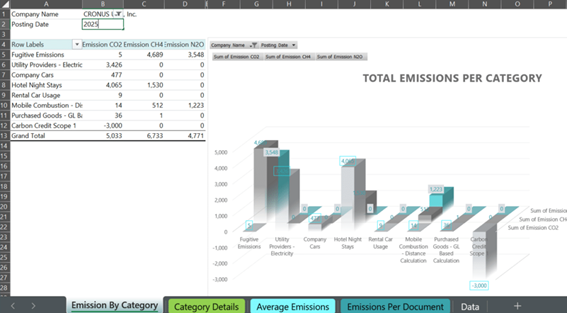
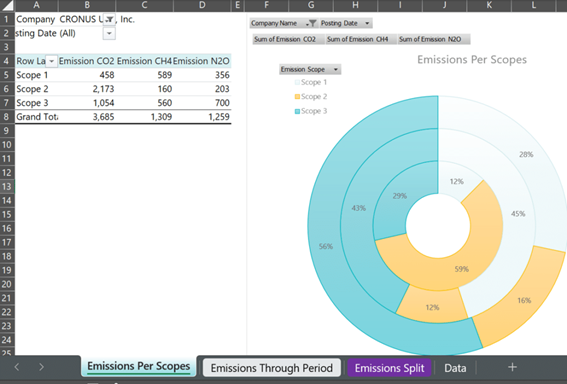
Sustainability Journal
Allows recording environmental data based on purchase documents, fuel and electricity consumption, and other inputs. The system automatically calculates emissions using configurable emission factors.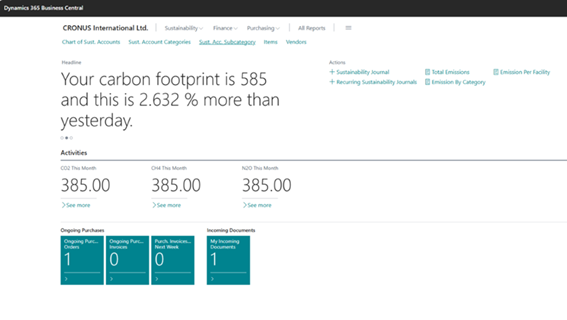
Carbon Credit Management
Companies can record carbon credit purchases and apply internal carbon pricing, facilitating emission offsetting and climate neutrality planning.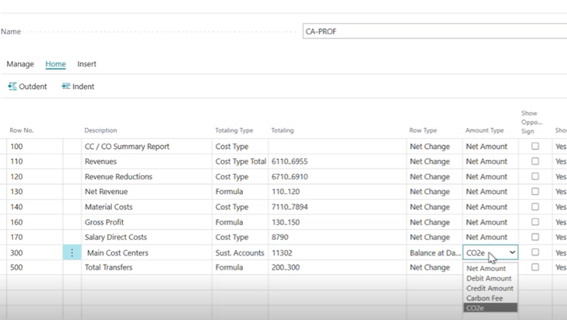
Environmental Scorecards and Targets
Provides dashboards with environmental goals and indicators, enabling real-time progress tracking and data-driven decision-making.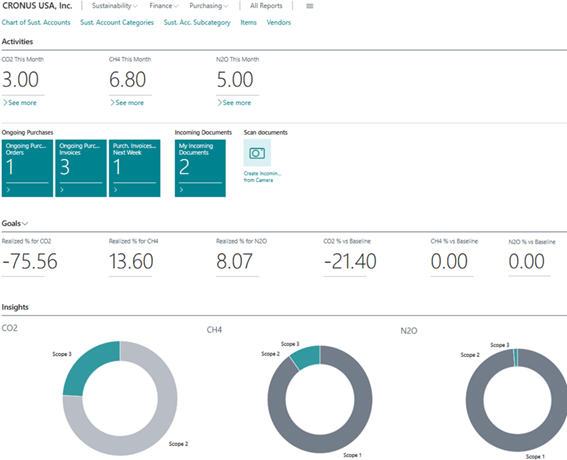
Sustainability Chart of Accounts
Similar to a financial chart of accounts, this structure organizes environmental data by categories such as energy, water, waste, and emissions, simplifying analysis and audits.Transforming Business Central into a Complete Environmental Management Platform
✅ Reduce regulatory risks by ensuring compliance with EU standards.✅ Enhance reputation among environmentally conscious customers and investors.
✅ Achieve operational efficiency by integrating sustainability into business processes.
✅ Gain competitive advantage by preparing for the future with a tech foundation aligned with evolving legal requirements.
The module not only helps companies reduce their environmental impact but also positions them competitively in a market increasingly driven by ESG criteria and regulations like the ESPR. If you're looking for an integrated solution for sustainability and compliance, Business Central with Sustainability Management could be your next strategic step.
Contact us to schedule a demo.
Referências:
EUR-Lex
EUROPEAN COMMISSION
CIRCABC